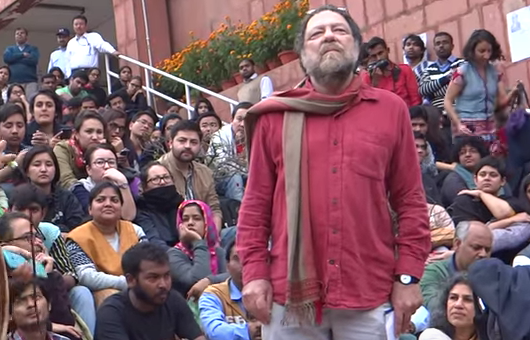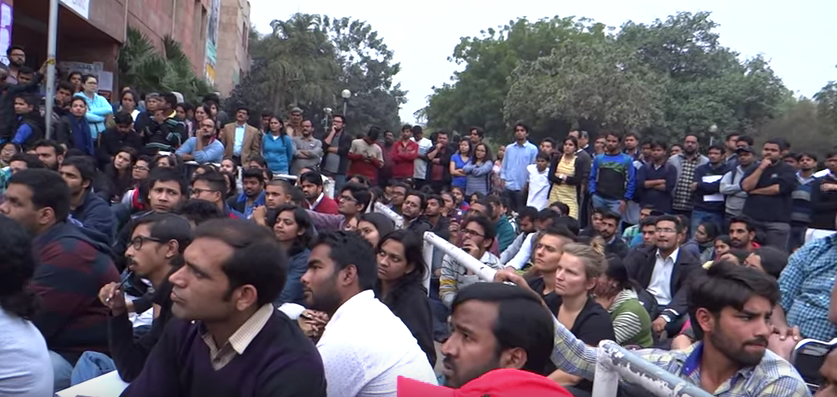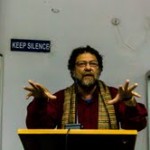India’s premier university Jawaharlal Nehru University (JNU) in Delhi, is currently in the middle of one of the biggest crackdowns on students in decades. Students who marched to mark the anniversary of the execution of a Kashmiri man found guilty of terrorism have been arrested, others are in hiding as a hysterical state apparatus clamps down on dissent. The crackdown has been so fierce that on Friday, Human Rights Watch (HRW) urged the Indian government to reconsider its decision to charge peaceful protesters with sedition and anti-national speech. ARI SITAS, currently visiting professor at JNU, says the signs are ominous for India’s democracy.
I was honoured to receive the Bhagat Singh Chair in Historical Studies at the Jawaharlal Nehru University in Delhi for this Monsoon Semester.
I am more than honoured to be amongst the most courageous colleagues and teachers who are defying the attempt to break the University and make it serve a rising communalism.
In the last few days I have witnessed first-hand how goons or gundas (as they are known here) have been taunting, provoking and trying to get a violent response from lecturers and students.
There is no doubt in my mind that India is entering a dangerous phase where criticism and dissent, the very notion of democracy itself, will be smashed in institution after institution with the full support of the mainstream media.
The way the JNU events were reported and misreported, the way nonsense was turned into fact and the way the slogans by right-wing communalists and students were ignored (or interpreted as something else, legitimate, obvious) reminds me of the worst times in apartheid South Africa on the cusp of dissent when protest was used as an alibi to foster violence.
This is the grand construction: JNU is harbouring anti-India dissent, terrorism and sedition. The Government needs to declare a state of emergency and sort out the problem. This is amplified by TV channel hosts and newspaper pundits as public opinion. And indeed, there is a growing public opinion in the social media that now wants JNU closed and smashed.
Waking up and looking at The Hindu online, the next morning, scared me. I have always told my students to read the media with the requisite subtlety to discern inflections that attempt to construct public opinion, moral panic or outrage. The word was “subtletyâ€. What was there was crudity- from the picture of demonstrating nationalists to the way the JNU issue was framed and constructed.
I am proud to be associated with some of the best historians, economists, sociologists, literary studies, art and aesthetics, natural and political science scholars that India has ever produced.
If they are the enemy of shining India I dread to imagine who her friends are.
Thousands gathered again outside the Administration as a dozen or so right-wingers tried to make noise. This time they were mostly students and I recognised two or three from earlier encounters.
The heavy “guys†from earlier on were not there. The Administration refused the largest meeting ever electricity!
Alumni, retired academics, and the cream of the Indian academy were there and even Rahul Gandhi arrived to demonstrate his support. The e-Cover of The Hindu again the next morning focused on the dozen right-wing people who were making a noise with the subtitle that they were protesting against Rahul Gandhi! I am delighted that thereafter the newspaper started getting more of a balanced take on events.
This moral panic. Why?
A moral panic that an institution is cultivating a hubris (excuse the Greek) or a mega-deviance is not new.
It starts usually with a mobilisation identifying perfidies (real, partly real or constructed) and it opens up the space for thousands of wannabes and moral entrepreneurs to have a field day, add invective, add “experience†and insight about Shaitan’s pelt and wares. Such a panic from what I have observed is being amplified right now about JNU.
Serious studies of the history of deviance point to a normal separation: those who shout, who get shrill and who mobilise are rarely the “fixersâ€. It was in the main the voices of declining classes and status groups who felt that their way of life has been violated that started the ruckus.
Many such attempts failed, but some did succeed. This creates the climate for a range of fixers, modernists, traditionalists, reformers to also have their day. Fixing usually involves the isolation, incarceration and pummelling of such deviants. On occasion such fixers changed the codes and laws to recognise space for such miscreants. We owe after all some of the freedoms we enjoy to them.
What should make everyone take a breather though and take a minute to think is that in this case where JNU has been made to be this Shaitan, it is a strutting government and the party in the government of the day who are whipping up the discontent and creating a successful moral panic.
And there are a range of moral entrepreneurs who are embellishing that into shrillness.
The attentive sociologist should take stock of who they are and what is the reason for their outbursts. Unmistakable here is the role of the media and a range of media houses.
There are precedents for such mobilisations of discontent but they mostly happened in authoritarian and dictatorial environments or on the cusp of a dictatorial ascendance. That it happens through a party and an apparatus that has a potentially vulnerable majority until the next election, demands some serious further reflection. Do they get it that they might lose badly or are they preparing for polarisation that will legitimise an authoritarian suspension of democratic rule?
The language of a state of emergency that was aired during the first days of amplifying such rhetoric was particularly worrying. It granted the immediate right to authoritative violence. Furthermore, if it can carry the day out of half a dozen students chanting a series of slogans, it can become the methodology of rule throughout.
Why is JNU considered to be deviant? Hasn’t JNU been JNU for a while and haven’t the kind of slogans chanted by students, however alarming, been chanted throughout the years? I have a hunch that it is not about JNU at all!
Is it far-fetched to imagine that perhaps JNU presents itself as the perfect alibi- anti-national, terrorist-supporting and breeding Shaitanism, for something ELSE?!
Could it be in other words that JNU has provided the context for a kind of hegemony in action where the leadership of the BJP is actively trying to keep the tryst (and perhaps expand it) between its corporate and elite bigwigs in Shining India and the increasingly restless actual and potential foot-soldiers who are being left behind?
If there were cracks in that tryst, the high profile and noise around the intervention would be a wonderful moment for papering the cracks. BJP lost in Delhi and Bihar recently. If this hegemony in and through action is the order of the day, why should they care if in the process this institution is damaged or not (and JNU will be deeply affected and damaged) what matters is that its deviance is made productive. For that, it would be ready to deploy any number of goons (and I have witnessed some of them first hand twice intimidating students and teachers) to invade the campus and be shown to be sorting out the gremlins of this anti-national outrage.
For the middle class that supports the BJP’s strategy, JNU is anyway an anachronism in the new knowledge economy and a throwback to the days of isolation and poverty- education has to be an instrument of corporate success. For the other strata this site of perfidy has to be smashed and to be shown to be smashed. What started as an institutional system of riot production has found its twin, the media personalities who have specialised in symbolic lynching.
Of course the majority of teachers and students at JNU are defending its turf, its ethos and the right of the SU president, Kanhayia Kumar, to make such a (and dare I say from the translations I have seen) patriotic speech.
And the mobilisations to defend this turf have been inclusive, nonviolent and exemplary. That its stand is spreading out towards all Universities, Colleges and Tertiary Institutions in the country is a fascinating outcome. This is the stand of an important and yet small section of society, because it is not about rational debate. Rohit Vermula who had committed suicide in Hyderabad and Kanhayia Kumar bruised and beaten and charged for sedition are quickly rising as the faces of martyrdom in a peculiar tipping point. So far, the support for JNU from social movements and mass-based parties has been symbolic, it is only when that gains traction in society that the moral panic shall dissipate in earnest. That the other parties are beginning to move is evident since the 18th of February where people are beginning to walk the talk. I think a remarkable counter-movement is afoot.
Ari Sitas is a professor in Sociology at UCT and current Bhagat Singh Chair at the Department of Historical Studies at JNU, Delhi
Read more:











